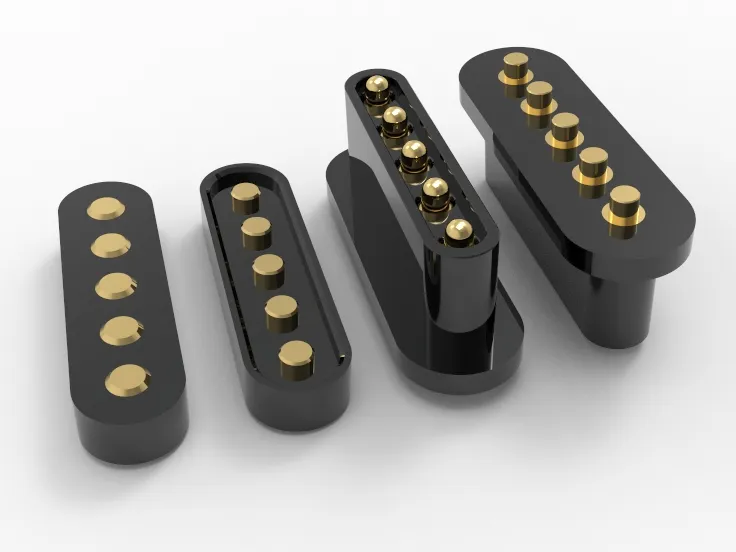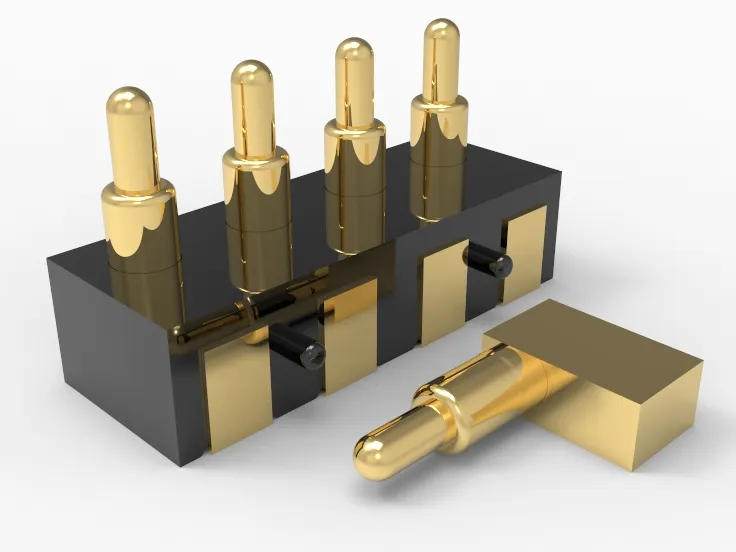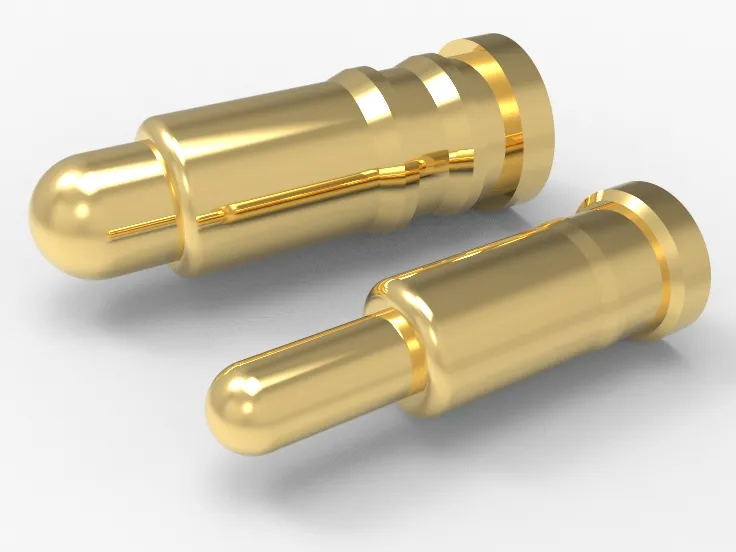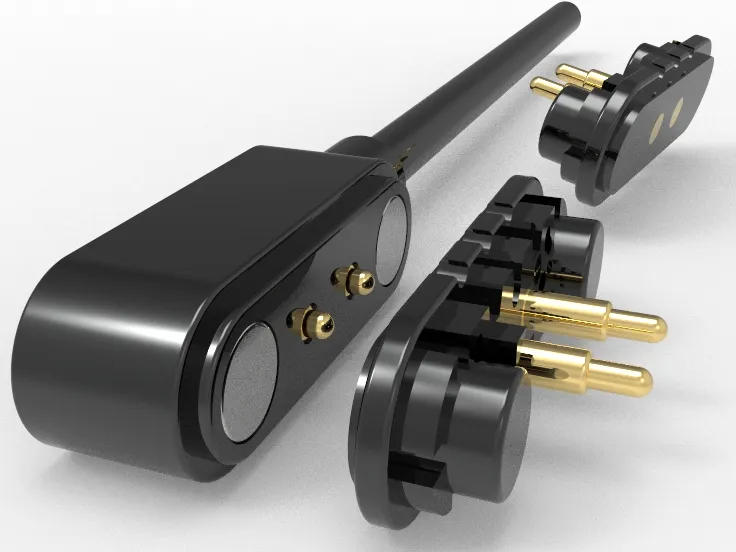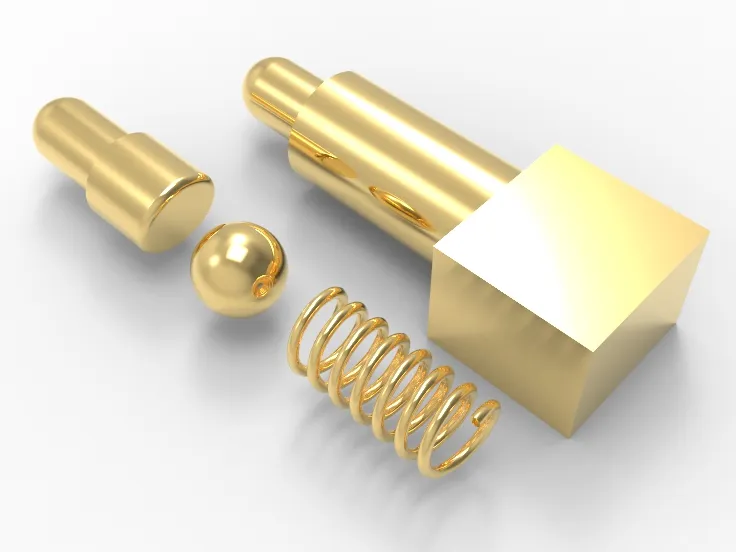What Is Pitch? Best Guides to Pogo Pin Connector Selection. Find Out How Pitch Impacts Your Choice of Pogo Pin Connector and Why it Matters
1. Introduction: What Is Pitch?
“Pitch” is a crucial yet often overlooked concept in electronic connector design. It affects the size and arrangement of Pogo Pin connector, and directly impacts your product’s performance and reliability. So, what is Pitch? How do you choose the right Pitch to ensure optimal performance for your Pogo Pin connector?
This blog will explore the importance of Pitch and the factors to consider when choosing the right Pitch, helping you make informed decisions for superior product performance.
2. What Is Pitch? Pitch Defined in Pogo Pin Connector
In Pogo Pin connector design, Pitch refers to the center-to-center distance between adjacent Pogo Pins. This parameter is essential as it affects electrical performance, signal integrity, connector size, and cost.
- How the pitch is chosen depends on what the electrical and mechanical specs require. For high-speed signal transmission or high-current applications, a larger Pitch can reduce electromagnetic interference and crosstalk, ensuring signal integrity and stability. Conversely, a smaller Pitch can maximize PCB area usage in space-constrained scenarios and increase connector density.
- Choosing the right Pitch involves considering signal transmission needs and manufacturing feasibility. Smaller Pitch generally increases manufacturing difficulty and demands higher precision from production equipment. Additionally, Pitch selection must balance electrical performance with mechanical strength to ensure connector durability and stability.
- Pitch choice significantly affects the final performance of Pogo Pin connector. Too large a Pitch can make connectors too bulky for modern electronics, while too small a Pitch can increase production costs and affect reliability. Therefore, selecting the right Pitch involves balancing application needs, electrical performance, mechanical requirements, and manufacturing processes for optimal design outcomes.
3. What Is Pitch? Impact of Pitch on Pogo Pin Connector Performance
Pitch is a critical parameter in Pogo Pin connector design, affecting overall performance and reliability. Pitch is the center-to-center distance between adjacent pins, and it influences connector size, electrical performance, mechanical strength, and manufacturing.
3.1 Electrical Performance:
- Smaller Pitch reduces connector size but can increase electrical interference and crosstalk, especially in high-frequency applications, leading to signal integrity issues. A larger pitch cuts down on interference and keeps signal transmission steady.
3.2 Mechanical Strength:
- Pitch affects the mechanical strength and durability of connectors. Smaller Pitch can weaken pin support, increasing the risk of bending or breakage, especially in frequent use. Proper Pitch provides better support, enhancing durability and extending lifespan.
3.3 Manufacturing Process:
- Smaller Pitch requires precise manufacturing equipment, increasing costs and defect rates. Wider Pitch simplifies manufacturing, improving efficiency and yield.
3.4 Heat Management:
- In high-power or high-temperature environments, Pitch affects heat dissipation. Smaller Pitch can restrict cooling, leading to overheating. Larger Pitch allows better heat dispersion, maintaining stable temperatures.
3.5 Application Fit:
- Different applications have different Pitch needs. For compact devices, smaller Pitch saves space, while larger Pitch reduces current density and heat in high-current scenarios.
Pitch affects Pogo Pin connector size, electrical performance, mechanical strength, manufacturing, heat management, and application suitability. Consider these factors to ensure optimal performance and reliability in various applications.
4. What Is Pitch? Common Pitch Sizes for Pogo Pin Connector
In connector design, “Pitch” is the center-to-center distance between adjacent pins or contacts. For Pogo Pin connector, the pitch size directly affects the connector’s stability, reliability, and manufacturability.
4.1 Common Pitch Sizes:
- 0.4mm – 0.5mm: Used in tiny electronic devices like smartphones and wearables. This small pitch allows for high pin density but requires precise manufacturing and is more sensitive to mechanical stress.
- 0.8mm – 1.0mm: Ideal for consumer electronics such as tablets and laptops. It balances pin density with stable production and offers good mechanical strength and durability.
- 1.27mm – 2.54mm: Suitable for industrial equipment, communication devices, and automotive electronics that need high current transmission. It provides strong electrical and mechanical performance but increases the connector’s size, making it less suitable for compact devices.
4.2 Choosing the Right Pitch:
- 4.2.1. Electrical Requirements: Smaller pitches suit low current, while larger pitches handle high current and power applications.
4.2.2. Mechanical Strength: Larger pitches generally offer better mechanical strength, suitable for frequent insertions and heavy loads.
4.2.3. Size Constraints: For tight spaces, choose a smaller pitch to maximize pin density, but be aware of higher manufacturing difficulty and cost.
4.3 Design and Manufacturing Considerations:
- Choosing the right pitch involves balancing electrical and mechanical needs with manufacturing feasibility. Smaller pitches demand higher precision, increasing costs, while larger pitches are easier to produce but may waste space in compact devices. Aim for a pitch that meets technical requirements and remains cost-effective.
5. Key Factors for Choosing the Right Pitch, What Is Pitch?
Selecting the right pitch ensures the reliability, stability, and lifespan of Pogo Pin connector while optimizing performance in complex environments:
- Mechanical Strength and Stability: Smaller pitches can fit more connection points in tight spaces but may reduce mechanical strength. Make sure the pitch size matches the structural strength to avoid bending or breaking over time.
- Electrical Performance: Pitch size affects electrical performance, including impedance, insertion loss, and signal integrity. Larger pitches often reduce EMI between adjacent pins, improving signal stability and clarity, especially in high-speed applications.
- Manufacturing Constraints: Smaller pitches can complicate manufacturing and increase costs, with a higher risk of pin shorting. Pick a pitch that matches what your factory can handle to keep things functional and budget-friendly.
- Heat Dissipation: Pitch impacts heat dissipation. Smaller pitches can concentrate heat, particularly in high-power applications, leading to overheating. Select the right pitch to optimize heat management and prevent failures.
- Environmental Adaptability: Different environments have varying pitch requirements. Larger pitches in harsh conditions (e.g., high humidity or pollution) help reduce contamination and short-circuit risks, enhancing environmental adaptability.
- Cost Efficiency: Consider the cost-effectiveness of the pitch. Smaller pitches save space and increase integration but may incur higher manufacturing and maintenance costs. Balance space utilization with economic considerations to choose the most cost-effective pitch.
Selecting the ideal pitch for Pogo Pin connector involves evaluating mechanical, electrical, manufacturing, heat dissipation, environmental, and cost factors to ensure high performance and reliability.
6. Pitch and Other Connector Parameters, What Is Pitch?
In Pogo Pin connector design and selection, Pitch is crucial. This refers to how much room there is between pog pins that are close together, usually measured in millimeters. The right Pitch affects the connector’s performance and suitability and must be balanced with other key parameters:
- Contact Force and Pitch: A smaller Pitch means closer pins, which can reduce contact force. Weak contact force may affect connection stability. Therefore, in smaller Pitch designs, optimizing pin materials and spring design is essential to ensure sufficient contact force.
- Current Capacity and Pitch: The current capacity relates to pin cross-sectional area and Pitch. Smaller Pitch may limit pin size, affecting current capacity. For high-current applications, larger Pitch connectors are often needed to avoid overheating or damage.
- Durability and Pitch: Pitch size affects mechanical durability. Smaller Pitch increases mechanical stress between pins, reducing lifespan. For frequent insertions and removals, choose an appropriate Pitch to balance durability and size.
- Manufacturing Process and Pitch: Smaller Pitch requires higher manufacturing precision. As Pitch decreases, the difficulty and cost of production increase. Consider the feasibility and cost of production when selecting Pitch.
Choosing the right Pitch involves balancing contact force, current capacity, durability, and manufacturing process. Accurate calculations and testing can help find the optimal Pitch for your application, enhancing overall performance and reliability.
7. Future Trends: Innovation and Development in Pitch
Pitch size affects connector size, signal integrity, and mechanical performance. As electronic devices become smaller and denser, Pogo Pin connector is evolving towards smaller and more precise Pitch designs.
- Tiny Pitch Advances: Pitch will continue to shrink, with micron-level designs becoming common to meet the needs of high-density circuits and compact electronics.
- High-Frequency Signal Optimization: With 5G and high-speed communication growth, Pogo Pin connector must maintain signal integrity at smaller Pitch sizes. Future innovations will focus on optimizing materials and structures to reduce electromagnetic interference and signal loss.
- Advanced Manufacturing Technologies: Future Pitch designs will benefit from advanced automation, such as 3D printing and laser micromachining, enabling higher precision and consistency at micron levels.
- Integrated Multi-Function Designs: As Pitch decreases, Pogo Pin connector will integrate more functions, including power transfer, signal transmission, and heat management. Future designs will optimize both pin spacing and multi-function integration.
- Compatibility with Flexible PCBs: With the rise of flexible electronics, Pitch designs will increasingly consider compatibility with flexible PCBs. Designs that accommodate bending and deformation will become mainstream.
- Environmental Sustainability: Future Pitch designs will also focus on eco-friendliness, aiming to reduce material use and improve manufacturing efficiency for greener Pogo Pin connector.
Future developments will drive Pitch designs toward smaller, more precise, and integrated solutions, offering more reliable and efficient connections for next-generation electronics.
8. Summary and Recommendations, What Is Pitch?
In this article, we explored the importance of Pitch and how to choose the right Pitch for Pogo Pin connector to ensure long-term stability and efficiency.
8.1 Summary:
- Definition and Role: Pitch is the distance between the centers of adjacent pins in a Pogo Pin connector, affecting electrical performance and mechanical strength.
- Electrical Performance: Smaller Pitch increases pin count, boosting signal density but raising interference risk. Larger Pitch reduces interference but may limit signal transmission capability.
- Mechanical Strength: Pitch affects the connector’s strength and durability. Too small a Pitch can make pins vulnerable to damage, while too large a Pitch may increase size and cost.
- Choosing Pitch: Select Pitch based on signal needs, device size, manufacturing costs, and potential future upgrades.
8.2 Recommendations:
- Assess Application Needs: Evaluate signal requirements and size constraints to choose a Pitch that meets electrical needs without increasing device size or complexity.
- Consider Future Expansion: Plan for potential upgrades by selecting Pitch with adequate margin, allowing increased signal capacity without resizing the connector.
- Partner with Experts: Work with experienced manufacturers like Johoty to simulate and test Pitch options, ensuring connector stability and reliability.
- Regular Checks and Optimization: Periodically review connector performance and adjust Pitch based on actual usage to enhance device lifespan and reliability.
By following these guidelines, you can make informed decisions about Pogo Pin connector, ensuring efficient, reliable operation for various applications.
9. FAQ:
9.1 What is pitch in Pogo Pin connector?
- Pitch is the space between the centers of two nearby Pogo Pins, typically measured in millimeters. We currently offer a 1mm pitch. It’s a key parameter that affects the size, performance, and application range of Pogo Pin connector.
9.2 How do you choose the right pitch for optimal performance?
- Selecting the right pitch involves balancing electrical performance, mechanical strength, heat dissipation, and manufacturing feasibility. A smaller pitch saves space but can increase manufacturing complexity and cost, while a larger pitch improves heat dissipation and mechanical strength but takes up more space.
9.3 Why does pitch size affect connector reliability?
- Pitch size affects contact force, electrical resistance, and shock resistance. Smaller pitches can cause interference between pins, increasing electrical noise and signal crosstalk. Larger pitches provide better isolation and stronger mechanical performance, enhancing overall reliability.
9.4 How to ensure reliable contact with small pitch connectors in high-density applications?
- For high-density applications, reliable contact with small pitch connectors requires optimizing contact force and choosing the right materials. Using highly elastic materials and precision manufacturing techniques can ensure stable contact force and long-term reliability.
9.5 How does pitch selection impact the manufacturing process?
- Pitch size directly impacts the manufacturing process. Smaller pitches require more precise equipment and stricter quality control to prevent issues like short circuits or poor contact. We carefully consider pitch when designing and producing connectors to ensure manufacturing feasibility.
9.6 What are the future trends in pitch for Pogo Pin connector?
- With electronic devices getting more compact and powerful, the pitch sizes in Pogo Pin connector will become smaller. Miniature pitch designs will become more common, especially for high-density applications, driving advances in manufacturing processes and materials to meet these challenges.





